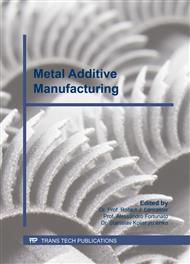p.155
p.163
p.169
p.176
p.182
p.193
p.199
p.205
p.212
Selective Laser Melting of Multi-Principal NiCrWFeTi Alloy: Processing, Microstructure and Performance
Abstract:
In this paper, a new type of multi-principal component Ni5Cr4WFe9Ti pre-alloyed spherical powder was designed and prepared. The method of selective laser melting (SLM) was used to fabricate the testing coupons, so that the Ni5Cr4WFe9Ti samples were prepared successfully. The preliminary processing parameters were determined by the energy density derived from Rosenthal model, combining the different processing parameters (e.g. laser power P, scanning speed V and scan scape), and the range of optimum processing parameters was obtained by orthogonal tests. The effects of energy density on the microstructure and mechanical properties of the materials were studied by XRD, SEM, DSC and room temperature static tensile tests. The results showed that the materials had a single phase FCC structure with good thermal stability, the melting point was 1418.9 °C, and there is no phase transformation until 1265.9 °C. The tensile strength, yield strength and plasticity were 981MPa, 733MPa and 16.1% respectively, which increase by 31.15%, 110.03% and 69.47%, respectively comparing to the as-cast samples,. These results demonstrate that SLM provides a new path for the additive manufacturing to fabricate multi-principal component alloys.
Info:
Periodical:
Pages:
182-189
Citation:
Online since:
January 2019
Authors:
Price:
Сopyright:
© 2019 Trans Tech Publications Ltd. All Rights Reserved
Share:
Citation:



